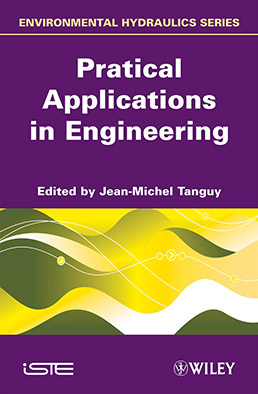
The study and management of water resources – especially the quantitative approach taken through the science of hydraulics and hydrology – is becoming increasingly important as those resources are affected by increasing population and development, the demands and consumption of industry, pollution, and climate change. Since the existence of water in the environment is also related to the role it plays in many other processes – from weather phenomena and climate, including heat transport in the atmosphere and oceans, to shaping the physical geography and geology of the landscape of rivers, plains, and coastal regions through erosion and deposition – this is a complex and interrelated field relating ecosystems, geography, climate, and planning and development among other topics.
This series of five volumes focused on environmental hydraulics studies the complete water (or hydrologic) cycle from meteorology to coastal morpho-dynamics, including looking at river hydraulics, hydrogeology and marine hydraulics. It describes these physical processes, and how they are observed in the real world, from catchment basins or watersheds where precipitation first falls, all the way through the transport of water to the sea. An inventory of ground measurement instruments, which provide necessary input data for the various modeling tools described in the book, is drawn up, and mathematical models describing each field within the overall subject area are detailed by a series of system equations. These are then solved by the use of numerical methods adapted to the particular characteristics of the application in question.
Many of the key modeling tools used by engineers in practice in the field are described in detail, as well as numerous examples of the application of the methods to real world problems, presented as case studies that highlight all of the processes described above.
Volume 4 contains a series of case studies, illustrating practical applications of these tools in engineering problems.
Part 1. Operational Hydrology
1. Developing the Flood Alert Map, Christophe Calas, Jean-Michel Tanguy and François Bressand.
2. Generation of a Flood in a Rapid Basin (Gard 2002), Georges-Marie Saulnier.
3. Forecasting a Flood in a Branched Network (Aude 1999), Jean-Michel Soubeyroux.
4. Hydrological Modeling Spatialized on Two Mediterranean River Basins. Application in Flood Forecasting, Arthur Marchandise and Christophe Bouvier.
5. Ensemble Hydrological Forecasting and Alert with the European Flood Alert System (EFAS): Case of the Danube Basin Floods in August 2005, Maria-Helena Ramos, Jutta Thielen and Ad De Roo.
Part 2. Fluvial Hydraulics
6. Propagation of a Flood in a Branched Network (Marne 1999), Patrick Chassé.
7. Flood Propagation in a Looped Network (Wateringues), Jean-Baptiste Faure.
8. Generation and Propagation of a Flash Flood on a River Basin (Aude 1999), Jacques Chorda and Marie Madeleine Maubourguet.
9. Dynamics of the Flooding of Floodable Flatlands (Aude 1999), Jean-Michel Tanguy.
10. Failure of a Dike in a Flood Environment (Agly 1999), André Paquier.
11. Flooding by Groundwater Upwelling at Remiremont (Moselle), Philippe Sergent.
12. NAVMER: Ship Path Simulator, Yann Hollocou and Son Ha Lam.
Part 3. Hydrogeology
13. Interaction between Surface and Subsurface Flows: Somme Basin, Dominique Thiéry.
14. Hydrogeological Modeling of the Karst System on the Lez River (Montpellier), Nathalie Dörfliger, Perrine Fleury, Bernard Ladouche and Hervé Jourde.
Part 4. Generation and Propagation of Floods in an Urban Environment
15. Hydraulic Study of the Marseille Vieux-Port River Basin, Frédéric Pons.
16. Hydraulic Study of the Aude River in the Carcassonne Crossing, Arielle Masson.
17. Failure of a Dike in an Urban Environment: Amboise, Jean-Michel Tanguy.
18. Study for the Prevention of Risks Associated with the Dikes of the Rhône and the Saône on Land Belonging to the Lyon Urban Community, Olivier Bertrand.
Part 5. Estuary Hydrodynamics
19. Real-Time Estuary Modeling (Adour Maritime), Jérôme Schoorens and Etienne Le Pape.
20. Operational Modeling of the Hydrodynamic Functioning of the Gironde Estuary, Réginald Sarralde.
21. 3D Modeling of Salinity and Sediment Suspension in the Loire Estuary: Coupling of Processes, Régis Walther and Eric David.
Part 6. Maritime Hydraulics
22. Numerical Modeling of Sea States, Bertrand Michard.
23. Taking Sea States into Account in Offshore Racing, Sylvain Mondon and Jean-Michel Lefèvre.
24. Agitation Study for Roscoff-Bloscon Marina, Pascal Lebreton.
25. Swell Agitation at Dunkirk’s Western Port, Pierre Debaillon.
Part 7. Transportation of Dissolved Substances, Pollution
26. Study of Water Quality in the Seine, Patrick Goblet and Stéphanie Even.
27. Drift Forecasts for the Erika and Prestige Oil Spills, Pierre Daniel.
Part 8. Fluvial and Maritime Morphodynamics
28. Evolution of River Beds: Example of the Arc River, André Paquier.
29. Modeling of Seabed Sediments Resuspension in the Dover Strait, Nicolas Guillou and Georges Chapalain.
30. Evolution of Beds around a Breakwater, Jean-Michel Tanguy.
31. Project to “Restore the Maritime Character of the Mont-Saint-Michel” Hydrosedimentary Studies, Eric Lagroy de Croutte.
Jean-Michel Tanguy is a French civil engineer who passed a master degree in Ice Hydraulics and a PhD in River Sediment Transport Modeling at Laval University, Quebec.